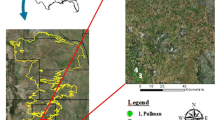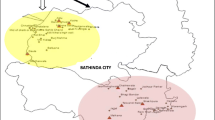Abstract
The bioavailability of arsenic (As) in the soil environment is largely governed by its adsorption–desorption reactions with soil constituents. We have investigated the sorption–desorption behaviour of As in four typical Bangladeshi soils subjected to irrigation with As-contaminated groundwater. The total As content of soils (160 samples) from the Laksham district ranged from <0.03 to approximately 43 mg kg−1. Despite the low total soil As content, the concentration of As in the pore water of soils freshly irrigated with As-contaminated groundwater ranged from 0.01 to 0.1 mg l−1. However, when these soils were allowed to dry, the concentration of As released in the pore water decreased to undetectable levels. Remoistening of soils to field moisture over a 10-day period resulted in a significant (up to 0.06 mg l−1) release of As in the pore water of soils containing >10 mg As kg−1 soil, indicating the potential availability of As. In soils containing <5 mg As kg−1, As was not detected in the pore water. A comparison of Bangladeshi soils with strongly weathered long-term As-contaminated soils from Queensland, Australia showed a much greater release of As in water extracts from the Australian soils. However, this was attributed to the much higher loading of As in these Australian soils. The correlation of pore water As with other inorganic ions (P, S) showed a strongly significant (P < 0.001) relationship with P, although there was no significant relationship between As and other inorganic cations, such as Fe and Mn. Batch sorption studies showed an appreciable capacity for both AsV and AsIII sorption, with AsV being retained in much greater concentrations than AsIII.





Similar content being viewed by others
References
Adriano, D. C. (1986). Trace elements in the terrestrial environment. New York, NY: Springer-Verlag.
Alam, M. G. M., Allinson, G., Stagnitti, F., Tanaka, A., & Westbrooke, M. (2002). Metal concentrations in rice and pulses of Samta Village, Bangladesh. Bulletin of Environmental Contamination and Toxicology, 69, 323–329.
Bhattacharya, P., Chatterjee, D., & Jacks, G. (1997). Occurrence of As-contaminated groundwater in alluvial aquifers from the delta plains, eastern India: Options for safe drinking water supply. Water Resource Development, 13, 76–92.
Bhattacharya, P., Jacks, G., Jana, J., Sracek, A., Gustafsson, J. P., Chatterjee, D. (2001). Geochemistry of the Holocene alluvial sediments of Bengal Delta plain from West Bengal, India: Implications on arsenic contamination in groundwater. In: G. Jacks, P. Bhattacharya, & A. A. Khan (Eds.), Groundwater arsenic contamination in the Bengal Delta Plain of Bangladesh (pp. 21–40). KTH Special Publication. TRITA-AMI Report 3084.
Elkhatib, E. A., Bennett, O. L., & Wright, R. J. (1984). Arsenite sorption and desorption in soils. Soil Science Society of America Journal, 48, 1025–1030.
Fordham, A. W., & Norrish, K. (1983). The nature of soil particles particularly those reacting with arsenate in a series of chemically treated samples. Australian Journal of Soil Research, 21, 455–477.
GENSTAT (1997). Statistical package. GenStat 5 Release 4.1. Rothamsted Experimental Station, Lawes Agricultural Trust, UK
Goldberg, S., & Glaubig, R. A. (1988). Anion sorption on a calcareous, montmorillonitic soil-Arsenic. Soil Science Society of America Journal, 52, 1297–1300.
Imamul Huq, S. M., Rahman, A., Sultana, S., & Naidu, R. (2003). Extent and severity of arsenic contamination in soils of Bangladesh. In: M. F. Ahmed & Z. A. Ali (Eds.) Fate of arsenic in the environment (pp. 69–84). Dhaka, Bangladesh: BUET-UNU International Symposium
Imamul Huq, S. M., Correll, R., & Naidu, R. (2006). Arsenic accumulation in food sources in Bangladesh. In R. Naidu, et al. (Eds.), Managing arsenic in the environment: From soil to human health (pp. 283–294). Collingwood, Australia: CSIRO.
Livesey, N. T., & Huang, P. M. (1981). Adsorption of arsenate by soils and its relation to selected chemical properties and anions. Soil Science, 134, 88–94.
Lund, U., & Fobian, A. (1991). Pollution of two soils by arsenic, chromium and copper, Denmark. Geoderma, 49, 83–103.
McLaren, R. G., Naidu, R., Smith, J. and Tiller, K. G. (1998). Fractionation and distribution of arsenic in soils contaminated by cattle dip. J. Environmental Quality 27, 348-354.
Manful, G.A., Verloo M., & de Spiegeleer, R. (1989). Arsenate sorption by soils in relation to pH and selected anions. Pedologie 39:55–68
Manning, B. A., & Goldberg, S. (1996). Modeling competitive adsorption of arsenate with phosphate and molybdate on oxide minerals. Soil Science Society of America Journal, 60, 121–131.
Manning, B. A., & Goldberg, S. (1997). Arsenic(III) and arsenic(V) adsorption on three California soils. Soil Science, 162, 886–895.
Meharg, A. A. (2004). Arsenic in rice—understanding a new disaster for South-East Asia. Trends in Plant Science, 9, 415–417.
Meharg, A. A., & Rahman, M. D. M. (2003). Arsenic contamination of Bangladesh paddy field soils: Implications for rice contribution to arsenic consumption. Environmental Science and Technology, 37, 229–234.
Naidu, R., & Nadebaum, P. (2002). Geogenic arsenic and associated toxicity problems in groundwater-soil-plant-animal-human continuum. In H. C. W. Skinner & A. Berger (Eds.), Geology to health: Closing the gap (pp. 37–44). Oxford University Press.
Naidu, R., Smith, E., Owens, G., Bhattacharya, P., & Nadebaum, P. (2006). Managing arsenic in the environment from soil to human health (p. 747). Collingwood, Melbourne: CSIRO.
Pierce, M. L., & Moore, C. B. (1980). Adsorption of arsenite on amorphous iron hydroxide from dilute aqueous solution. Environmental Science and Technology, 14, 214–216.
Rayment, G. E. & Higginson, F. R. (1992). Australian laboratory handbook of soil and water chemical methods. Melbourne: Inkata Press
Roy, W. R., Hassett, J. J., & Griffin, R. A. (1986). Competitive coefficients for the adsorption of arsenate, molybdate and phosphate mixtures by soils. Soil Science Society of America Journal, 50, 1176–1182.
Sakata, M. (1987). Relationship between adsorption of arsenic (III) and boron by soil and soil properties. Environmental Science and Technology, 21, 1126–1130.
Schulze, D. G. (1989). An introduction to soil mineralogy. In J. B. Dixon & S. B. Weed (Eds.), Minerals in soil environments (pp. 1–34). Madison, WI: SSSA.
Schwertmann, U., & Taylor, R. M. (1989). Iron oxides. In J. B. Dixon & S. B. Weed (Eds.), Minerals in soil environments (pp. 379–437). Madison, WI: SSSA.
Smith, E., Naidu, R., & Alston, A. M. (1998). Arsenic in the soil environment: A review. Advances in Agronomy, 64, 149–195.
Smith, E., Naidu, R., & Alston, A. M. (1999). Chemistry of arsenic in soils: I. Sorption of arsenate and arsenite by four Australian soils. Journal of Environmental Quality, 28, 1719–1726.
Smith, E., Naidu, R., & Alston, A. M. (2002). Chemistry of inorganic arsenic in soils: II. Effect of phosphorus, sodium, and calcium on arsenic sorption. Journal of Environmental Quality, 31, 557–563.
Sun, X., & Doner, H. E. (1996). An investigation of arsenate and arsenite bonding structures on goethite by FTIR. Soil Science, 161, 865–872.
Xu, H., Allard, B., & Grimvall, A. (1991). Effects of acidification and natural organic materials on the mobility of arsenic in the environment. Water, Air, and Soil Pollution, 57, 269–278.
Yan, X. P., Kerrich, R., & Hendry, M. J. (2000). Distribution of arsenic(III), arsenic(V), and total inorganic arsenic in porewaters from a thick till and clay-rich aquitard sequence, Saskatchewan, Canada. Geochimica et Cosmochimica Acta, 62, 2637–2648.
Author information
Authors and Affiliations
Corresponding author
Rights and permissions
About this article
Cite this article
Naidu, R., Smith, E., Imamul Huq, S.M. et al. Sorption and bioavailability of arsenic in selected Bangladesh soils. Environ Geochem Health 31 (Suppl 1), 61–68 (2009). https://doi.org/10.1007/s10653-008-9229-y
Received:
Revised:
Accepted:
Published:
Issue Date:
DOI: https://doi.org/10.1007/s10653-008-9229-y




